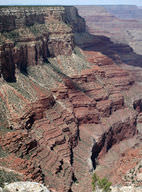4.12: Sedimentary Rocks
- Page ID
- 5372
Where can you go to see sediments?
Sediments are everywhere! One of the most fun places to see sediments is on a beach. Squishing sand between your toes is a great way to experience sediments first hand (or foot).
Sedimentary Rocks
Most sedimentary rocks form from sediments. The sediments must be packed together to form a rock. Sedimentary rocks also form as minerals precipitate from saline water. Sedimentary rock formation is described in the next concept.
Sediments
Sediments are small fragments of rocks and minerals. Pebbles, sand, silt, and clay are examples of sediments. Sedimentary rocks may include fossils. Fossils are materials left behind by once-living organisms. Fossils can be pieces of the organism, like bones. They can also be traces of the organism, like footprints.
Transport
Sediments are transported by water, wind, ice, or gravity. These agents move them from the place where they formed. The sediments are then deposited in a location.
Deposition
Sediments will eventually settle out of water (Figure below). For example, rivers carry lots of sediment. Where the water slows, it dumps these sediments along its banks, into lakes, and the ocean.
Cobbles, pebbles, and sands are the sediments that are seen on this beach.
When sediments settle out of water, they form horizontal layers. A layer of sediment is deposited. Then the next layer is deposited on top of that layer. So each layer in a sedimentary rock is younger than the layer under it (Figure below).
The rock layers at the Grand Canyon are horizontal. We know that layers at the bottom are older than layers at the top.
Sediments are deposited in many different types of environments. Beaches and deserts collect large deposits of sand. Sediments also end up at the bottom of the ocean and in lakes, ponds, rivers, marshes, and swamps. Avalanches produce large piles of sediment. The environment where the sediments are deposited determines the type of sedimentary rock that can form.
Summary
- Sediments are small fragments of minerals, rocks, or fossils.
- Sediments range in size from tiny bits of silt or clay to enormous boulders.
- Sediments are deposited in many different environments.
Review
- What are sediments? What sizes are sediments?
- What two things are needed to make a sedimentary rock?
- What does the environment where sediments are deposited mean for the rock that eventually forms?




